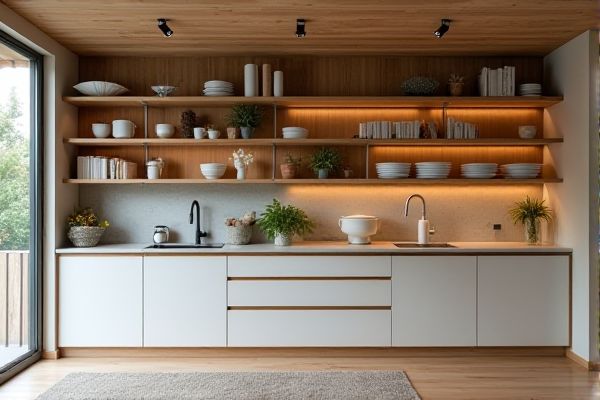
Open shelving offers easy access and displays your favorite items, creating a spacious and airy feel in your kitchen, while closed cabinetry provides concealed storage that reduces clutter and protects belongings from dust. Explore the rest of the article to determine which option best suits your style and storage needs.
Table of Comparison
| Feature | Open Shelving | Closed Cabinetry |
|---|---|---|
| Accessibility | Easy and quick access to items | Items concealed, access requires opening doors |
| Storage Capacity | Limited, best for lightweight or decorative items | Ample storage, ideal for bulky and various items |
| Visual Appeal | Creates open, airy look; showcases decor | Provides clean, uniform appearance |
| Maintenance | Requires frequent dusting and organization | Less frequent cleaning; protects contents from dust |
| Cost | Generally more affordable and easier to install | Usually higher cost due to materials and hardware |
| Customization | Flexible; easy to rearrange or add items | Highly customizable with various door styles and finishes |
| Use Case | Best for display, frequently used items | Ideal for privacy, organized storage of varied items |
Introduction to Open Shelving and Closed Cabinetry
Open shelving offers easy access and display options for kitchenware, creating an airy and visually appealing space, while closed cabinetry provides concealed storage that protects items from dust and clutter. Your choice between these two depends on your need for accessibility, aesthetic preferences, and the level of organization desired in your kitchen. Combining both approaches can optimize functionality and style by balancing visibility with hidden storage.
Aesthetic Differences Between Open and Closed Storage
Open shelving creates an airy, contemporary look by showcasing your items and adding visual interest through exposed organization, while closed cabinetry offers a sleek, uniform appearance that hides clutter and emphasizes clean lines. The choice impacts the overall aesthetic by either highlighting decorative elements and personal style or promoting a minimalist, streamlined environment. Your decision influences how space feels--open shelves lend warmth and accessibility, whereas closed cabinets enhance privacy and timeless elegance.
Practical Functionality: Daily Use Considerations
Open shelving offers easy access and visibility, making it ideal for frequently used items and promoting efficient daily routines. Closed cabinetry provides protection from dust and clutter, ensuring a tidier kitchen environment and safer storage for fragile or less-used items. Balancing open and closed options optimizes practical functionality by combining convenience with organized storage.
Storage Capacity and Organization
Open shelving offers easy access and visibility, making it ideal for frequently used items but typically provides less storage capacity than closed cabinetry. Closed cabinetry maximizes organization by concealing clutter and using adjustable shelves or compartments to accommodate various-sized items efficiently. Your choice depends on whether you prioritize quick accessibility or maximizing storage space and maintaining a tidy appearance.
Cleaning and Maintenance Requirements
Open shelving requires frequent dusting and regular cleaning to prevent buildup of dirt and grease, especially in kitchen environments where exposure to cooking residues is common. Closed cabinetry offers better protection against dust and grime, significantly reducing cleaning time and preserving the appearance of stored items. Choosing open shelves or closed cabinets depends on your willingness to commit to ongoing maintenance and the desired balance between accessibility and cleanliness.
Impact on Kitchen Space and Layout
Open shelving enhances the perception of kitchen space by creating an airy and visually expansive environment, making smaller kitchens feel larger and more open. Closed cabinetry provides ample concealed storage, reducing visual clutter and maintaining a clean, streamlined layout ideal for organizing utensils and appliances. The choice between open shelving and closed cabinetry directly influences kitchen functionality, aesthetic flow, and spatial efficiency.
Personalization and Styling Options
Open shelving offers extensive personalization through easy access and visibility, allowing homeowners to display decorative items, cookware, and collectibles that reflect their unique style. Closed cabinetry provides a clean, cohesive look and conceals clutter, which is ideal for those prioritizing a minimalist or polished kitchen aesthetic. Combining both offers flexibility to showcase personal touches on open shelves while maintaining organization and uniformity behind closed doors.
Cost Comparison: Open Shelves vs. Cabinetry
Open shelving typically costs less than closed cabinetry due to reduced material requirements and simpler installation processes. While open shelves use minimal hardware and fewer components, closed cabinets demand doors, hinges, and sometimes custom finishes, increasing expenses. Budget-conscious homeowners often choose open shelves to maximize storage without the higher price tag of traditional cabinetry.
Best Applications for Open Shelves
Open shelving works best in kitchens and living spaces where you want to display decorative items, frequently used dishes, or cookbooks, adding visual interest and easy access. Ideal for small kitchens, open shelves create an airy, spacious feel while encouraging organization and minimizing clutter. Your open shelves can be styled with baskets or jars to combine functionality with aesthetic appeal, making them perfect for casual, modern, or farmhouse-inspired designs.
Choosing Between Open Shelving and Closed Cabinets
Open shelving offers easy access and display opportunities, enhancing kitchen aesthetics with visible organization and lighter visual weight. Closed cabinetry provides concealed storage, protecting items from dust and creating a streamlined, clutter-free appearance ideal for maintaining a tidy kitchen. The choice depends on balancing accessibility needs, storage preferences, and design style within the available space.
 homyna.com
homyna.com